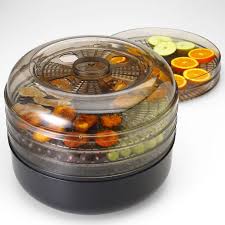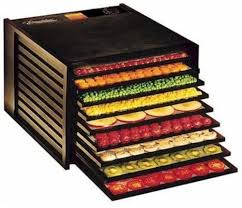Create Healthy Nutritious Food with a Home Dehydrator
 Drying fresh foods preserves precious nutrients and removes moisture that yeasts, bacteria and other molds need to survive. Although drying food also involves destroying some nutrients in micro amounts, the end result is a product that is nutrient dense…jamming more calories and dietary fiber along with minerals and vitamins into a smaller space.
Drying fresh foods preserves precious nutrients and removes moisture that yeasts, bacteria and other molds need to survive. Although drying food also involves destroying some nutrients in micro amounts, the end result is a product that is nutrient dense…jamming more calories and dietary fiber along with minerals and vitamins into a smaller space.
This gives dried foods a nutritional edge because with less water than their fresh food counterparts, their weight is reflective of solid foods…not added water weight. In other words, dried foods give us an array of concentrated flavors, minerals, vitamins and enzymes as well as fiber.
Dehydrating or drying foods is not a new technique, it is a preservation method that has been used and passed down for centuries (in Biblical times it was a necessity) eventually leading to the creation of the first food drying “food dehydrator” in 1795.
The food that a modern dehydrator produces has about 75 percent of the moisture removed.
Once your foods have been dehydrated they will need to be packaged properly in an airtight, moisture proof jar, bag, or other container of some sort and stored in a dark, cool area such as inside a pantry or a basement if you have one.
It’s always better to over-dry than under-dry your food because any moisture that is retained is still a threat to deterioration of your product.
Even when properly prepared and stored, different foods have different shelf lives.  According to the Department of Nutrition, Dietetics and Food Science at Brigham Young University, corn, wheat, rice and grains will last 30 years or more while veggies, fruits and pastas can last up to 30 years when properly prepared and stored. Milk substances such as powdered milk has a shorter lifespan of up to 20 years. You can make your own great organic flour by dehydrating organic grains and beans.
According to the Department of Nutrition, Dietetics and Food Science at Brigham Young University, corn, wheat, rice and grains will last 30 years or more while veggies, fruits and pastas can last up to 30 years when properly prepared and stored. Milk substances such as powdered milk has a shorter lifespan of up to 20 years. You can make your own great organic flour by dehydrating organic grains and beans.
Nearly all vitamin C and all Vitamin A-Beta Carotene found in plant foods is retained as well as important minerals like potassium, selenium and magnesium.
Unfortunately, many of the commercially dried foods are dried under temperatures that are too high (in order to get them to market faster) destroying more nutrient value. Always look for organic dried foods and the best idea yet is to invest in a home dehydrator where you’ll be in complete control of the environment and temperature used enabling you to preserve and create fresh nutritious foods at a fraction of the cost for yourself and your family.
You can enjoy many dried foods just as they are or you can add enough water to re-hydrate them for optimal taste…it’s really up to you. You can also use a steamer to plump them up again.
Like any other machine you invest in, they can range in price from 50 for basic machines to up into the hundreds for more professional models.
Dried foods are living foods because they have not been cooked. They not only are nutrient dense treats, they also retain the alkalinity of fresh produce (we know how important maintaining alkalinity is to our immune system) and inhibit the growth of bacteria. You can even use your food dehydrator to warm soups and sauces at very low temperatures as well as creating delicious raw breads, granola’s, crackers and cookies. You are only limited by your imagination.
Dried foods are the perfect choice for those on raw food diets as they provide new options for preparing foods, but these nutrient dense gems contribute to everyone’s health. They are the perfect food for everyone and provide both you and your family with new and tasty snack and meal options…all towards developing and maintaining a healthy diet.
Eating living foods energizes you. It’s a good thing!
Are you at risk for cancer? Find out what your present risks are, just take my one minute quiz and see what it revels.